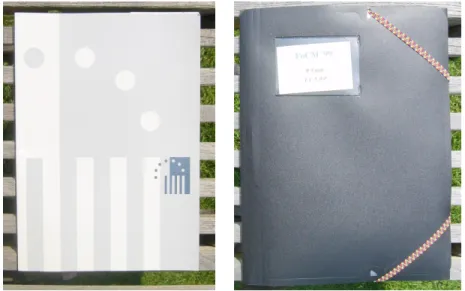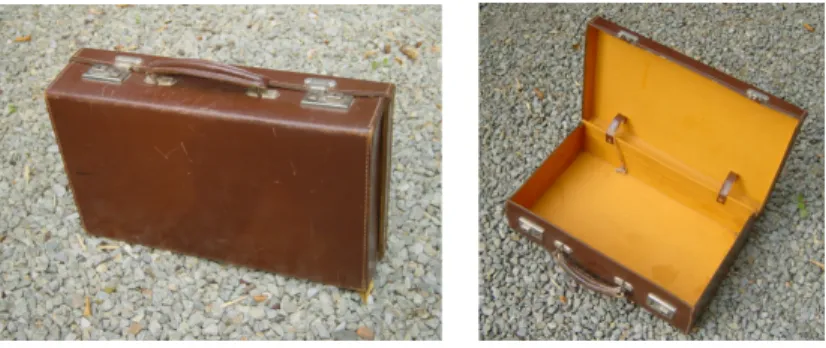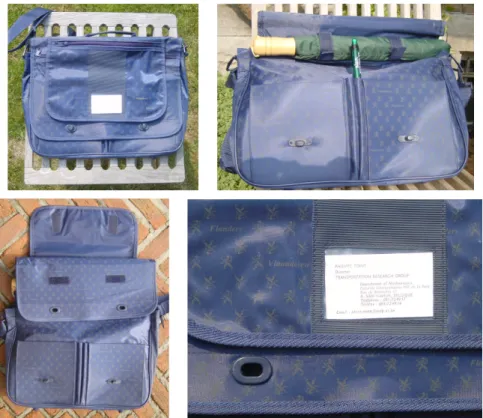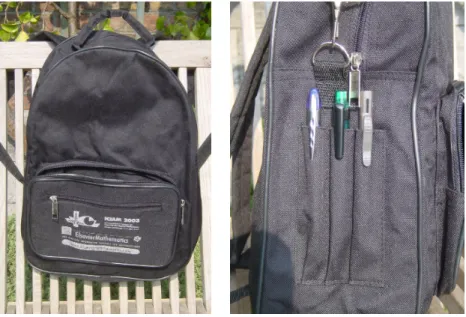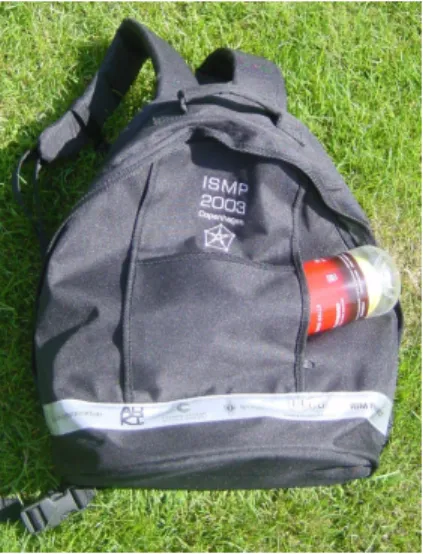RESEARCH OUTPUTS / RÉSULTATS DE RECHERCHE
Author(s) - Auteur(s) :
Publication date - Date de publication :
Permanent link - Permalien :
Rights / License - Licence de droit d’auteur :
Bibliothèque Universitaire Moretus Plantin
Institutional Repository - Research Portal
Dépôt Institutionnel - Portail de la Recherche
researchportal.unamur.be
University of Namur
Some generic comments on the state of the art in the design of mathematical
information carriers
Toint, Philippe
Publication date:
2003
Document Version
Peer reviewed version
Link to publication
Citation for pulished version (HARVARD):
Toint, P 2003, Some generic comments on the state of the art in the design of mathematical information carriers. Technical report, vol. 16, FUNDP, Faculté des Sciences. Département de Mathématique., Namur, Belgium.
General rights
Copyright and moral rights for the publications made accessible in the public portal are retained by the authors and/or other copyright owners and it is a condition of accessing publications that users recognise and abide by the legal requirements associated with these rights. • Users may download and print one copy of any publication from the public portal for the purpose of private study or research. • You may not further distribute the material or use it for any profit-making activity or commercial gain
• You may freely distribute the URL identifying the publication in the public portal ? Take down policy
If you believe that this document breaches copyright please contact us providing details, and we will remove access to the work immediately and investigate your claim.
information carriers by Ph. L. Toint1
Report 03/16 September 9, 2003
1Department of Mathematics, University of Namur,
61, rue de Bruxelles, B-5000 Namur, Belgium, Email: philippe.toint@fundp.ac.be
Some generic comments on the state of the art in the
design of mathematical information carriers
Philippe L. Toint
9 September 2003
Abstract
This paper discusses the state of the art of a much under-researched and particularly under-documented domain of the mathematical research activities, namely the design of mathematical information carriers. The range of design variables is explored and a first broad classification is proposed. The argument is supported by first-hand experience and graphically illustrated.
1
Introduction
Today’s society emphasizes information and its movement, with a definite emphasis on its technological aspects. However, not every technology dealing with the transporta-tion of informatransporta-tion is the object of the same scrutinity. The purpose of this paper is to investigate an hitherto under-studied information carrying technology that all pro-fessional mathematicians, as delegates at world-wide technical meetings, use or abuse sooner or later: the conference bag.
As one of the most ubiquitous impedimenta of the mathematician’s professional life, the conference bag is in itself an interesting object of marketing(1) but also of
scientific investigation. But there is more than one additional reason that make this investigation worthwhile.
First of all, conference bags have been in use for a very long time: it is rumored (from Pythagoras, 612BC) that Pythagoras himself used such a tool to carry his impressive collection of spheres around, and also that the motivation behind Euler’s Koeningsberg bridge problem, which turned out to be a founding stone of graph theory, arose from the need to carry his bag in town (see Keinstein, 2000). Unfortunately, these ancient archeological artefacts are no longer available for detailed analysis, which is the reason why we restrict our attention, in this experimental study, to examples from 1970 to the present day (with a contrasting exception).
Secondly, and just as importantly, the design of conference bags is itself, if not a fully fledged independent and recognized discipline, at least an endeavouring task, whose results impact the very life of most mathematicians on the planet. One might, at first hand, think that this design involves relatively few variables, such as ruggedness,
(1)A quick web search returned more than 4400 references, including selling sites with evocative
names like conferencegear.com, screaminghotdeals.com, incentives-uk.com or teamclothing.co.za.
color and price(2), but this overly limited viewpoint must be, in our opinion, enlarged to include at least two other main classes of design variables: the useability variables and the esthetics variables. Amongst the useability variables, one should probably emphasize
• the adapatation of the bag to different paper sizes;
• the presence, number and position of various types of pockets,
• the carrying technique, involving such things as handles, shoulder straps, . . . • the bulk and foldability of the bag, and its compatibility with the increasingly
more restrictive airline definition of “cabin-size”, • its maintenance with emphasis on washability,
• its re-useability along the lines of its original design (at other conferences), but also for other purposes (including well-known uses such as CD storage box, sun-or rain-hat, beach carry-all, grocery tote, pet transpsun-ort, king-size(3) purse/wallet or shock absorber for wine bottles).
Variables associated with the esthetics of the bag of course include color and shape, but also
• material choice (from light cardboard to plastic, cloth or leather), • the quality and good taste of various embroideries, inscriptions and logos, • the noticeability of the bag, ranging from totally bland and neutral to the most
“tourist spotting” type.
Moreover, each of these variables may often be specialized further. For instance, the consideration of pockets should typically include variables relating to their specializa-tion: they may be specially designed to hold a business card or name tag, notepads, pens, pencils or (perhaps more usefully) erasers, pointing devices (mechanical or op-tical), portable phones, lunch tickets, (sun-)glasses, bananas or beer cans. As the attentive reader undoubtly realizes, these variations are endless, and a fully compre-hensive study of all the relevant design variables is a task much too daunting for a single paper. We will therefore adopt a more pragmatic, if less systematic, approach and attempt to isolate a number of these design points in some specific examples.
The paper is organized as follows. Section 2 briefly covers the simplest (folder-type) designs, while Section 3 explores a large class of more common “supple briefcase examples”. The more complex and advanced designs are reviewed in Section 4. Some conclusions and perspectives are finally presented in Section 5.
(2)The price variable is essentially irrelevant to most conference delegates, as the bag is typically
included in the conference registration fee as a non-optional feature. As the question of making conference bags optional (and the associated price) sounds really mean and exceeds the scope of the present study anyway, we will not discuss the price variable any longer. However, scientific rigour forces the author to recognize that price is nevertheless most often significant for conference organizers.
3
2
Folder designs
We first consider the folder designs. These are typically chosen at conferences with a tighter budget, or at one-day conferences, where one does not expect such wear and tear from intensive usage and throwing in hotel rooms.
The simplest one is a simple cardboard folder, possibly adorned with some local organization logo. This is advantageous from the organizer point of view as it can be re-used at similar events, but is not very practical for the conference delegate. The main drawback is that its technical content (important papers, crucial contact address lists, . . . ) are free to fall on the ground or elsewhere, which is particularly unpleasant at conference parties where the delegate’s hands are also involved in holding a glass of sparkling something or a wee snack. An simple yet elegant example of this design is shown on the left of Figure 2.1. A first important improvement is however to add closing elastic straps, as shown on the rather understated design on the right of this figure.
Figure 2.1: A simple cardboard folder (left) and a plastic folder with closing elastic straps and name tag (right)
A second crucial parameter in these design is the thickness of the folder. The first two examples are rather thin, which implies that the amount of interesting material to be gathered by the average delegate(4) is also rather thin. A bolder, more ambitious
design is to make the folder considerably thicker as shown in the leftmost example in Figure 2.2, whose bright color immediately attracts attention, which somewhat contra-dicts its otherwise surprising total lack of owner or organization identification. An ever thicker, and overall much better, design is that shown on the right of this figure: an eas-ily washable white plastic box about 5 cm thick, featuring a simple but snappy closing mechanism and, crucially, an attached blue plastic handle. This last bag has proved to be especially useful, both at the conference and later(5). Its stylish shape, verging, in
(4)To be distinguished from the author, whose folders were of course overflowing.
Figure 2.2: High capacity plastic folder with closing elastic straps (left) and an inter-esting plastic box design with handle (right)
its stripped down simplicity, on the current neo-babylonian trends (see Thicket, 2003), is calculated as to easily contain both US-letter and A4 size documents and to protect them from unwanted external hazards (such as rain, not an uncommon occurence in the country where the associated conference was held).
From a more historical perspective, the white box design can be viewed as a radically streamlined successor of the 1930’s elegant bag shown in Figure 2.3.
Figure 2.3: A venerable leather conference bag: simple design highlighted by very high quality material
3
Tote and briefcase designs
The next step of sophistication is to provide a textile tote bag, again suitable for A4 and US-letter paper sizes, possibly also featuring pockets. Examples are shown in Figure 3.1 and on the left of the top-left picture of Figure 3.3. The pockets are a definite plus, as they avoid mixing technical papers with other tidbits of conference equipment. These bags can be nicely folded. The length of the handle is crucial, since it may cause the bag to gather dust on the ground when carried by short delegates.
We now turn our attention to the larger class of bags that are modelled after the briefcase idea, although typically in a supple material. Despite their unifying concept, the resulting bags may show a surprising diversity, as illustrated by Figure 3.3 on page 6. Amongst the interesting variations, one notes
5
Figure 3.1: Two very practical tote designs with (useful) pockets
• the common but not ubiquitous presence of both a handle and a shoulder strap, • the degree of rigidity (compare the two pictures in the third row),
• the overall design style, from classical (top right) to more baroque (bottom left), • the importance of the logo and the technique used for its display (Figure 3.2
shows different technical choices from embroidery to simple spray painting), • the endless specialization of pockets (Figure 3.4, page 7, shows a portable phone
pocket and an internal lunch ticket pocket),
• the opening position: its placement at the top of the bag, as in the left picture of the fourth row or of the bottom row of Figure 3.3, is considerably most con-venient (especially when simultaneously fetching your business card in the bag and passing the mayonnaise sandwich tray to your neighbour at the conference welcoming party).
7
Figure 3.4: A world of pockets
4
More advanced designs
We conclude our tour of conference bags by examining three more elaborate(6)designs.
The first is shown in Figure 4.1. It is derived from the briefcase type of the preceding section, but has a number of additional snazzy features.
Figure 4.1: A complex multi-pocket design
First and most noticeably, it has a second smaller overlaping cover, that closes on top of the bag and contains one additional zipped pocket as well as a style-conscious
(6)We will refrain from venturing into the exotic, as the insulated bag for conference in hot climates,
name tag pocket (bottom right picture). The usual larger cover also has a zipped pocket, and there are two additional pockets on the body of the bag plus another zipped pocket inside the bag! Surprisingly, the back does not have any. A flexible handle and a shoulder strap make carrying easy. The umbrella holder, shown in the top right picture, is a wonderfully useful idea (that is if you have an umbrella). The main body also offers two long thin folds for storing pens, but these are unfortunately too thin to hold a SIAM pencil, as shown on the same picture.
Even putting this annoying detail aside, experimental research suggests that the designer has been a little carried away in his or her desire to impress. The main problem is that the bag somewhat suffers from its excessive number of different storage compartments, illustrating once again that you can have too much of a good thing. It is indeed very easy to forget in which pocket you have stored your conference dinner ticket or your CD player, and one tends to look rather silly when frantically exploring no less than seven successive pockets. . .
A second, and, in the author’s opinion, more promising, approach is presented in Figure 4.2.
Figure 4.2: An interesting rucksack design (general view and detail)
This next design in our study is original in that it is based on a rucksack design. This has the considerable (and so far seemingly unnoticed) advantage of leaving both hands free when carrying it on your back, and we have seen above that there are conference circumstances where this is handy. The soft handle also makes it easy to carry as an ordinary bag, which is also useful (it is inconvenient to sit down at a sunny cafe terrace or, perhaps, in an auditorium with the bulk of your science on the back). Adequate pencil and eraser holders (right picture) adorn one of the side. The main pouch is large enough to hold papers or overly-late referee’s reports in both european and american formats, and the two smaller pockets in the front are ideal for storing
9
various useful items as cards, notepad, maps, compass, GPS, water tank, sun cream(7) or latest SciFi novel.
This radically new design is not without minor flaws. Figure 4.3 illustrates that the thin plastic separator between the two front pockets is too fragile and can easily be torn or punctured (in this case by sushi chopsticks). Ideally, one would also like to see an additional pocket of the type shown in in the left part of Figure 3.4 on the side opposite to the pen holder. . .
Figure 4.3: A too fragile pocket separator
The last considered design (see Figure 4.4) was brought to our attention by one of the referees of this paper, and can be viewed as a variation on the previous one.
Figure 4.4: Another rucksack design
This design obviously capitalizes on the strong points of the rucksack approach (free hands, additional handle). If the pen pockets are no longer supplied, one nevertheless notes the presence of an internal pocket for lunch tickets. The quality of the material is also remarkable. If the referee’s description shows his/her enthousiasm:
“The Scandinavian flair for design has finally been unleashed on the confer-ence bag. The sober, yet practical black design with the stylish silver grey reflector strip presents a quantum leap in the conference bag development. Future generations of bags will be measured against this modern classic!”
our scientific outlook leads us to adopt a more restrained yet positive attitude: we therefore simply suggest that these new rucksack approaches, possibly influenced by Scottish Montrose tickers or kiwi trampers, open an interesting track in this crucial subject.
5
Conclusions and perspectives
We have proposed a first analysis of the design of conference bags, with an attempt to isolate the relevant variables and their practical impact. We have also provided a first broad classification of these fascinating mathematical information carriers, but are aware that it is, for now, partial and incomplete. In particular, the underlying cultural influences, both endogenous and extrogenous, and their subtle impact of the Lacanian “self” are likely to require further research work if they have to be properly identified. Interestingly, we observe that most of our comments, variable selection and classi-fication techniques can be generalized without too much effort to bags at conferences that are not mathematical, therefore opening a new vibrant(8) area of research.
The author believes that first results presented in this paper are highly encouraging, and that further recommendations could be made in order to improve today’s designs. These improvements should in turn have a clear positive impact on the challenging life of delegates at mathematical conferences and other world-wide mathematical working parties, as well on other conference bag users (see Figure 5.1). After all, the world was not made in a single day.
Figure 5.1: A busy non-standard user
Acknowledgements
The author is thankful for the many interesting discussions with colleagues while the work described in this paper was in progress. It is a particular pleasure to mention Nathalia Alexandrov and Virginia Torczon as two of the nice guys who facilitated the collection of some of the experimental data. The author is also grateful to the Belgian Fund for Scientific Research for supporting the sabbatical mission during which this ground-breaking research was conducted. The positive contribution of three anonymous yet well-identified referees is finally acknowledged.
11
References
N. Keinstein. A philosophico-behavioural outlook on L. Euler’s petty grievances. Rumor Press, Isle of Silly, 2000.
Pythagoras. private communication, 612BC.
G. W. Thicket. New styles in Bagdad. The Fashion Heritage, 2, 2003.
Wompro. Insulated conference bag. Product 1887 in the Wompro Online Catalog at www.quote.wompro.com, 2003.
